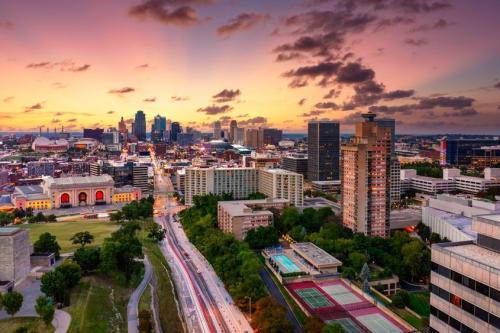Check out the Intermountain West states on this map from the Metro Program’s “State of Metropolitan America.” Now look at the major metropolitan areas—Phoenix, Denver, Provo and Ogden, Albuquerque and others. Do you notice how most of the major metropolitan areas excepting Las Vegas, Salt Lake, and Boise have being seeing growing shares of their workers commuting by public transit?
It’s but one finding among dozens in the extensive drill-down on what’s happening in U.S. metros that is the “State of Metropolitan America,” but the blue dots on the “Change in share of workers commuting by public transportation since 2000” map point to a major development: The Intermountain West is not just a region of solitary auto drivers and, in fact, has begun to make impressive strides in improving the availability of especially rail alternatives to the car.
The story is truly impressive. Ever since our 2007 report Mountain Megas we have been noticing that the Intermountain West metros—too young to have obtained the massive federal transport investments of 1960s and 1970s but growing too fast to be able to wait—have exhibited a striking appetite for self-help on transportation and economic development issues. But when it comes to rail and light rail, the Mountain metros’ story of do-it-yourself leadership is world class as makes clear this presentation given by John Inglish of the Utah Transit Authority at the Copenhagen United Nations climate talks last winter.
Let’s review the bidding of major projects, several of which are too new to “explain” the progress on public transit commuting but which will soon influence it.
In the Phoenix-Mesa-Scottsdale metro area the first line of METRO, a $1.4 billion light rail system, has been a big hit since it in December 2008 after voters extended a half cent sales tax for regional transportation in 2004. The 20-mile line carried almost 70 percent more riders in April compared to the projections for the initial operation.
In metro Denver, recession-induced sales tax revenue declines have weakened the finances of FasTracks but construction continues on the $6.7 billion initiative to build 122 miles of new commuter and light rail (plus some bus rapid transit and station parking). Voters launched this ambitious project when they approved a 20-year, 0.4 percent sales tax in 2004.
For their part, the three major metros along Utah’s Wasatch Front megalopolis (Provo-Orem to the south, Ogden-Clearfield to the north, and Salt Lake City in between) are in the process of adding 70 miles of track to the region’s existing 64-mile light and commuter rail network by 2015. Voters approved a quarter-cent sales tax to fund the $2.8 billion project, called FrontLines, in 2006.
And for that matter New Mexico’s RailRunner stands out as an exemplar of strategic state investment in metropolitan areas. Governor Richardson celebrated the inaugural journey of this $390 million commuter rail line which traverses the 50 miles between neighboring Albuquerque and Santa Fe in December 2008.
Nor is rail transit the only sort being explored. Within its environs metro Las Vegas may not have light rail on the drawing boards but it’s investing considerable sums in bus rapid transit. Working outside its boundaries, metro Colorado Springs has been operating the Front Range Express, a commuter bus shuttling workers from CS into Denver since 2005.
In this respect the Mountain metros—belying their reputation for auto-oriented neglect of transit—have been busily building systems, and doing it in characteristically western fashion: with bottom-up local effort and a can-do spirit. To be sure, public transit use still trails the national average in all of the large Mountain metros. And it’s true that the commuting data still report only modest transit use for getting to work, with many of the new links having only opened in the last few years. Yet the fact remains that the percentages are trending upwards and can be expected to trend up faster now that more light rail and other transit lines will be coming on line in the next few years.
In short, bootstrapping and self-help have carried the Intermountain West metros a long way in the last decade when it comes to crafting 21st-century, multi-modal transportation systems. But just think what could be achieved if the region obtained its fair share of a truly merit-based, mode-neutral federal transport program that put transit and highway investments on the same footing and provided metros more discretion. That would really be something to see.



Commentary
Bootstrapping Rail Transit: Progress in the Mountain Metros
May 25, 2010